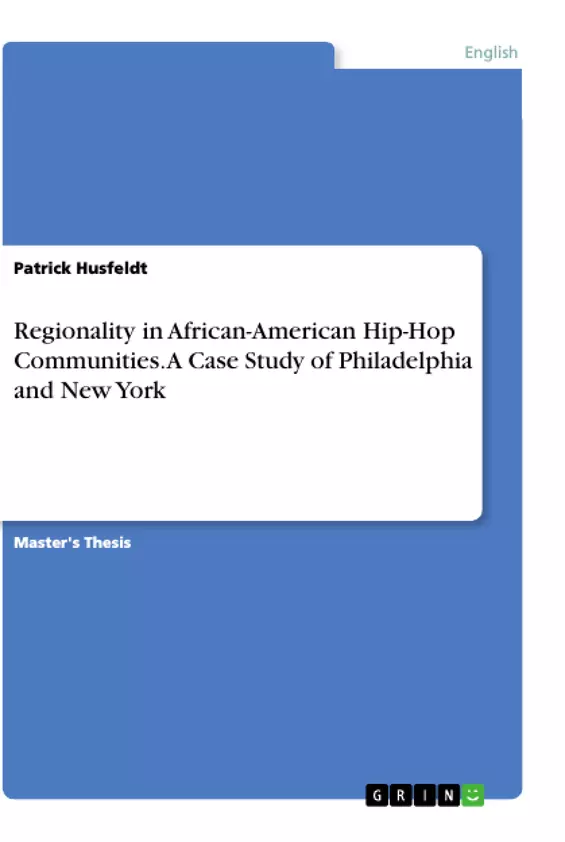This thesis will address whether regional variation across members of the hip-hop community is measurable in terms of regionally distinct phonological and syntactical properties.
As a starting point, New York City has been selected as it marks the origin of hip-hop. Philadelphia, as part of Labov’s Mid-Atlantic region and Jones’ self-coined "Northeast region", which itself is said to be characterized by “nonhomogeneity” (Jones 2015: 428), serves as a point of reference for the comparison of distinct regional features. Labov (2001: 121) also refers to the “Philadelphia dialect area”, which is clearly separated from New York in the North.
The data for the analysis will be retrieved from randomly chosen songs performed by selected African-American hip-hop artists who are representative of their respective city and who can be considered authentic members of the local hip-hop community. Further information on the selection will be provided later on. First, the theoretical background to the study of this thesis will be provided, mainly refer-ring to the role of regionality in AAVE (as African American Vernacular English) by giving an overview of earlier and current research. Second, after narrowing down the selection of artists and their songs, the relevant phonological and syntactical features will be listed and explained before they are analysed for both Philadelphia and New York City. Finally, the results will be interpreted and discussed with respect to the guiding question of this thesis.
Inhaltsverzeichnis (Table of Contents)
- 1. Introduction
- 2. Background to the study
- 2.1 Regional variation in AAVE
- 2.2 Regionality in hip-hop
- 3. Analysis
- 3.1 Remarks on selected artists and songs
- 3.2 Remarks on selected variables
- 3.2.1 Phonological variables
- 3.2.2 Syntactical variables
- 3.3 Philadelphia
- 3.3.1 Phonology
- 3.3.1.1 Fronting of GOOSE and GOAT vowels
- 3.3.1.2 Vocalization of /1/
- 3.3.1.3 Postvocalic /r/
- 3.3.1.4 Realization of TRAP/BATH/DANCE
- 3.3.1.5 Raising of THOUGHT
- 3.3.1.6 Dental fricatives
- 3.3.1.7 Glide weakening/monophthongization of PRICE
- 3.3.1.8 hill/heel merger
- 3.3.1.9 DRESS/KIT merger
- 3.3.2 Syntax
- 3.3.2.1 Copula deletion
- 3.3.2.2 Invariant be
- 3.3.2.4 Negation
- 3.3.3 Conclusion
- 3.4 New York
- 3.4.1 Phonology
- 3.4.1.1 Fronting of GOOSE and GOAT vowels
- 3.4.1.2 Vocalization of /l/
- 3.4.1.3 Postvocalic /r/
- 3.4.1.4 Realization of TRAP/BATH/DANCE
- 3.4.1.5 Raising of THOUGHT
- 3.4.1.6 Dental fricatives
- 3.4.1.7 Glide weakening/monophthongization of PRICE
- 3.4.1.8 hill/heel merger
- 3.4.1.9 DRESS/KIT merger
- 3.4.2 Syntax
- 3.4.2.1 Copula Deletion
- 3.4.2.2 Invariant be
- 3.4.2.3 Negation
- 3.4.3 Conclusion
- 4. Discussion of the results
- Regional variation in AAVE
- Phonological and syntactic features of AAVE
- Hip-hop as a cultural and linguistic phenomenon
- Language variation and social identity
- The impact of geographic location on language use
- Chapter 1: Introduction
- Chapter 2: Background to the study
- Chapter 3: Analysis
- Chapter 3.3 Philadelphia
- Chapter 3.4 New York
Zielsetzung und Themenschwerpunkte (Objectives and Key Themes)
This master's thesis examines regional variation in African-American Vernacular English (AAVE) within hip-hop communities in Philadelphia and New York City. The study aims to analyze the phonological and syntactic features of AAVE in these two distinct regions and identify key differences in language use.
Zusammenfassung der Kapitel (Chapter Summaries)
This chapter introduces the topic of regional variation in AAVE, specifically focusing on hip-hop communities in Philadelphia and New York City. It outlines the research question and the methodology used in the study.
This chapter provides a background on the topic of regional variation in AAVE, discussing the historical development of the language and the factors that contribute to regional differences. It also examines the role of hip-hop as a cultural and linguistic force in shaping regional variations in AAVE.
This chapter presents the core analysis of the study, examining the phonological and syntactic features of AAVE in Philadelphia and New York City. It analyzes data from selected artists and songs, focusing on key variables such as vowel fronting, vocalization of /l/, postvocalic /r/, and copula deletion.
This section provides a detailed analysis of AAVE in Philadelphia, examining the phonological and syntactic features of the language. It discusses the specific realizations of various phonological variables, such as the fronting of GOOSE and GOAT vowels, the vocalization of /l/, and the realization of TRAP/BATH/DANCE.
This section presents a parallel analysis of AAVE in New York City, comparing and contrasting its phonological and syntactic features with those of Philadelphia. It examines the same phonological and syntactic variables as in the Philadelphia section, highlighting any significant regional differences.
Schlüsselwörter (Keywords)
This study examines the regional variations in AAVE, specifically focusing on phonological and syntactic features within hip-hop communities of Philadelphia and New York City. The key terms and concepts include AAVE, hip-hop, regional variation, phonology, syntax, language variation, social identity, geographic location, and cultural influence.
- Arbeit zitieren
- Patrick Husfeldt (Autor:in), 2018, Regionality in African-American Hip-Hop Communities. A Case Study of Philadelphia and New York, München, GRIN Verlag, https://www.grin.com/document/550887



